9 best tools for product owners to streamline your workflow and maximize impact

One of the key roles within a scrum team, the most popular agile framework, is the product owner.
A product owner manages the product backlog and determines what goes into the product.
Definition of a Product Owner (PO)
The product owner (PO) represents next to the Scrum Master and the development team a key player in a Scrum team. This role entails product management responsibilities, implicitly increasing the value of a product by governing tasks according to the vision of a product.
Strategy comes from the product manager and the product owner works with the team on implementation. They ensure that the backlog is prioritized with the most important items at the top and the least important at the very bottom, and keep key stakeholders informed as they work with their team (design and development) to bring solutions to life.
What is a product owner?
A product owner has a crucial role within the Scrum framework. Their role includes decision-making, management, and prioritization responsibilities. The overall purpose of a product owner is to bridge the gap between product strategy and development by promoting collaboration and ideas that will add value to the product.
The product owner is solely responsible for communicating between all parties involved in development, including the development team, customers, stakeholders, and so on. They will also need to evaluate any decisions regarding the development process to ensure the decision will add value and remain in the scope of the product vision.
The main responsibilities of a product owner include:
Defining the product vision: The product owner defines the product vision and ensures that it aligns with the overall business goals and market needs.
Managing the product backlog: The PO will create, prioritize, and maintain the product backlog in a way that is clear and accessible to the development team and stakeholders.
Prioritization and decision-making: The PO must prioritize the backlog based on factors like business value, customer needs, and dependencies. This will mean that the development team is focussed on the right tasks at the right time.
Stakeholder engagement: Product owners are the primary point of contact for customers, business managers, and other relevant parties. They gather input and feedback to ensure the product meets customer and market demands.
Communication and clarification: The PO will maintain an open dialogue with the development team to ensure everyone understands the tasks and the desired outcomes.
Acceptance criteria and validation: The product owner will define the acceptance criteria for the work items and validate the completed work to make sure it meets the requirements. This ensures that all deliverables are ready for release.
Iteration planning and review: Product owners need to be involved with planning meetings, sprint reviews, and retrospectives to provide feedback and make any adjustments. They will also present any feedback that may alter the development plan.

Product owner vs. product manager: What's the difference?
The product manager and product owner roles are often confused with each other. The two roles share a range of responsibilities and key skills such as communication, customer focus, problem-solving, prioritization, analytical thinking, market analysis and collaboration. Despite being hands-off when it comes to development, both roles also require strong technical knowledge.
Understanding the differences between these roles can be helpful when it comes to running a project smoothly. Let’s break down some of the key differences:
Different scopes of responsibility
The product owner primarily focuses on the execution and delivery aspects of a product. They manage the product backlog, ensure alignment with the development team, and deliver features that reflect the product vision. The PO will work closely with the development team and occasionally interact with stakeholders.
The product manager oversees the entire product lifecycle from concept to market and beyond. They are involved in planning strategy, roadmapping, and handling customer feedback. They will also define the product vision and ensure the product meets market needs while maintaining alignment with business objectives. The product manager will interact with a broader range of stakeholders, including marketing, sales, customer support, and executive leadership.

Different types of decisions
The product owner makes tactical decisions about what the development team should work on next. They prioritize user stories, manage the product backlog, and make real-time adjustments to meet sprint goals. Their focus is on short-term goals and iterative progress.
The product manager makes strategic decisions that shape the overall direction and success of the product. They define product features, market positioning, pricing, and go-to-market strategies. Their focus is on long-term vision and market impact.
Different skill sets
Key skills for a product owner include Agile methodologies, backlog management, user story creation, sprint planning, stakeholder communication, and team collaboration. They often require a solid understanding of the product's technical aspects to effectively prioritize and communicate with the development team.
Key skills for a product manager include market analysis, product strategy, competitive analysis, user research, and cross-functional leadership. They require strong business acumen, customer insight, and the ability to balance strategic and tactical thinking.
Different goals
The product owner aims to maximize the development team's efficiency and deliver value incrementally. They ensure the team meets sprint goals and stakeholder expectations, focusing on short-term deliverables and continuous improvement.
The product manager aims to create a successful product that meets market needs and drives business growth. They work to achieve product-market fit, increase market share, and ensure long-term success, focusing on the overall vision and strategic objectives.
Different responsibilities
The product owner is responsible for creating, refining, and prioritizing the product backlog. They communicate product requirements and priorities to the development team and act as the primary point of contact to clarify requirements and provide feedback.
The product manager is responsible for defining the product vision, strategy, and roadmap. They coordinate with various departments to ensure product alignment with business goals, represent the voice of the customer, conduct market research, and analyze competitive landscapes to inform product decisions.
Why do product owners need tools?
Given the close relationship that product owners have with their product team, they have key tools that they rely on to accomplish their tasks. These tools assist them with:
Managing and prioritizing work
Tracking and communicating progress
Collecting feedback
Generating insights
Aligning with the roadmap
Supporting product strategy
And much more
Many tools cater to these responsibilities to support product owners and a few shine above the rest. We are going to outline some of them here.
At the end of this article, you will know:
A few of the common tools that product owners use and why
How they are used by product owners and their teams
Pros and cons of each tool
Their costs
And more
Let’s get started.

1. airfocus

How about one tool that has the capabilities to support product owners with fulfilling their key responsibilities?
This is where airfocus comes in, a platform for the new way of doing product management.
While other tools may force you to work a certain way, or work well with a small team but present challenges when scaling, airfocus is modular. You can build it to fit your teams’ best practices and scales as your product(s) and team grows.
It enables product owners to understand the product strategy, work directly with their delivery teams to craft and ship solutions, and communicate with key stakeholders as they build and support their products.
airfocus enables product teams to build better products.
Product owners can ensure that they are building solutions that align with the right strategy. Post launch they can collect feedback and generate insights.
airfocus can also be used to prioritize feedback and craft product roadmaps (comes with support for multiple ready-made templates). And if you rely on JIRA, or other other project management tools, it has multiple integrations which include: Jira, Trello, ASANA, Microsoft Planner, Intercom, Slack, and more.
Ratings: G2 - 4.4 stars
Demos: Getting Started with airfocus.
Pricing: Plans start at $59 per editor per month.
Free trial: Yes.
Pros:
Built directly for product teams that prefer an outcome-based approach to building products
Extremely easy to gather insights, prioritize work, and make the connection between strategy and execution
Modular, so you can adapt it to your teams’ specific needs and processes
Offers multiple integrations to connect with the tools you already rely on
Cons:
Modularity can take bit of time to grasp over
2. Trello
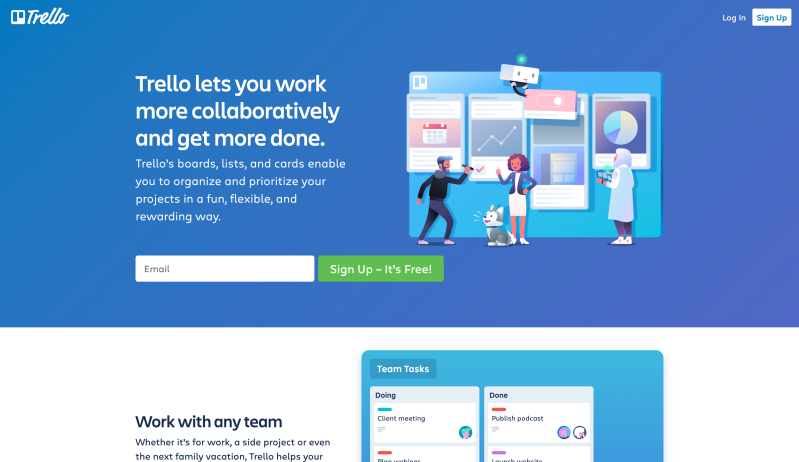
Trello is a collaboration tool that makes it easy to work with your team in a few easy steps, especially with Kanban.
It has come far since launching in 2011 with even more developments made since being acquired by Atlassian in 2017. It is free for individuals and teams looking to get started, with a $5 per user/month starting price for additional workspaces, features, and storage.
Ratings: G2 - 4.4 stars
Demos: Boost your productivity with Trello.
Pricing: Plans start at $5 per user per month.
Free trial: Yes.
Pros:
Visually appealing and easy to use
Cards can be customized in each board to work your way
Ability to track tasks by individuals and communicate with members
“Power-Ups” to enable additional features and integrations into your workflow
Cons:
Not specifically a product management tool, but rather a tool for task management
Lacks roadmapping capabilities
Challenging to connect workflow for a holistic view of work to complete
3. JIRA
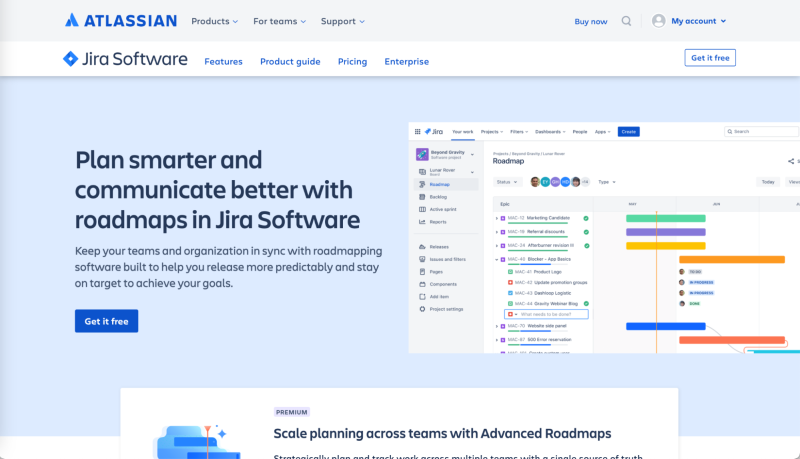
JIRA is one of the most well-known tools in the software industry for managing the software development life cycle. It is a super powerful tool that supports multiple agile methodologies, whether working in Scrum, Kanban, or more. You can even customize it to work your way.
For product owners, it gives them full visibility into all parts of the software development life cycle, but also enables them to assign, track, and easily report on work while collaborating with team members. Free for up to 10 users, the price then increases to $17.75 per user/month.
Ratings: G2 - 4.3 stars
Demos: Project Management with Jira | Atlassian.
Pricing: Plans start at $8.15 per user per month.
Free trial: Yes, for up to 10 users.
Pros:
Easy to organize multiple teams and projects
Track team velocity to understand how quickly work is performed
Multiple integrations to other tools for development, design, documentation, project management, and more
Cons:
Not a product management tool but rather a great tool for software development
Has a steep learning curve and is time-consuming to set up the tool and permissions
Lacks a standardized version so it is up to the organization to set it up in a way that works for them
One of the most expensive tools on the market
4. Aha!
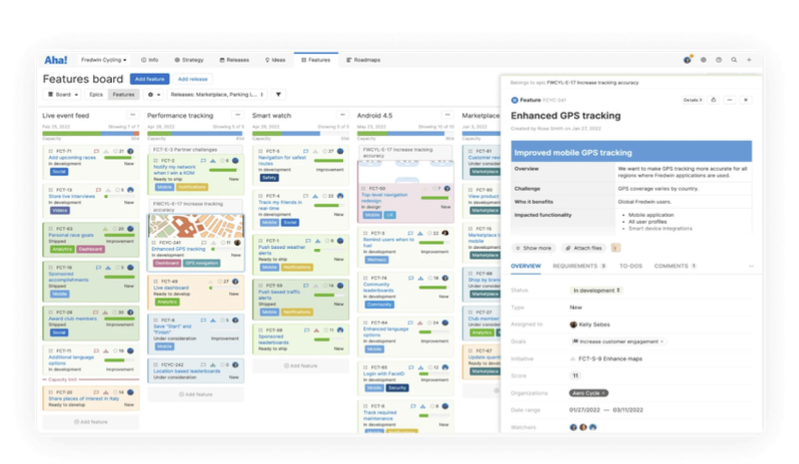
Aha! Is a roadmapping tool for product teams to create roadmaps and share their product development plans.
Roadmaps can be customized to meet the needs of various audiences, shared via custom presentations or secure web pages, and with its ideas portal product teams can crowdsource feedback, engage with their community, and analyze trends.
Ratings: G2 - 4.3 stars
Demos: Aha! Roadmaps | Getting Started.
Pricing: Plans start at $59 per user per month.
Free trial: Yes.
Pros:
Map solutions to the product strategy
Advanced backlog management capabilities
Integrates with third-party tools
Crowdsource feedback and engage with your community
Cons:
Timeline-based roadmapping, which does not work for modern product teams that want an outcome-based approach
Users have mentioned that its user interface needs work
Requires a learning curve to implement
At a $59/user/month cost, the cost is high for contributors. You will pay for many features which you may hardly use
5. Canny.io
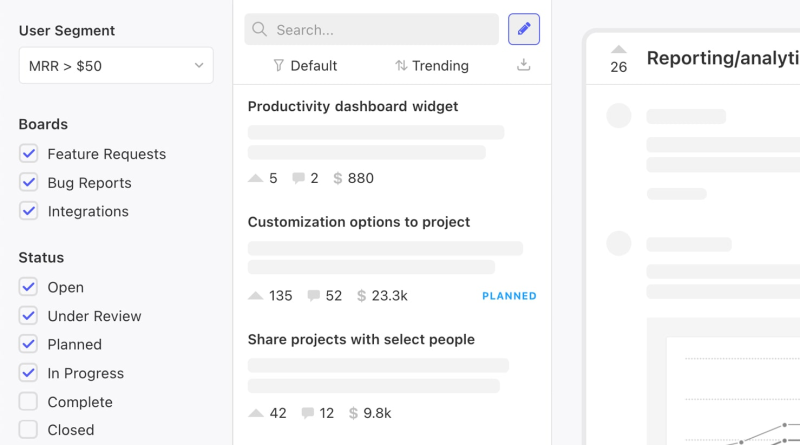
Once a product owner has worked with their team to ship a feature, it is imperative to gather customer feedback to not only understand how customers feel about it but also to understand what future problems can be solved.
Canny enables product teams to capture, organize, and analyze product feedback in one central location to inform product decisions. Not only can it be embedded directly into a product, but it also supports a roadmap to inform customers which feedback will be acted upon.
It starts free with 2 boards but then increases in price to $400/month for an unlimited number of boards and managers. Ratings: G2 - 4.5 stars
Demos: Canny 101 | Full Tutorial | Demo
Pricing: Free plan with basic features. Paid plans start at $99 per month.
Free trial: Yes.
Pros:
Clean and intuitive user interface
Easy to learn with a quick setup
Multiple integrations to connect with tools you already use
Customers can vote to express their interest for a feature
Cons:
Prioritizes based on feature requests and not problems to be solved
Too focused on insights and lacks several setups for PM practices
Restrictive roadmap setup and capabilities
The price makes it out of reach for startups and B2C companies
6. Monday
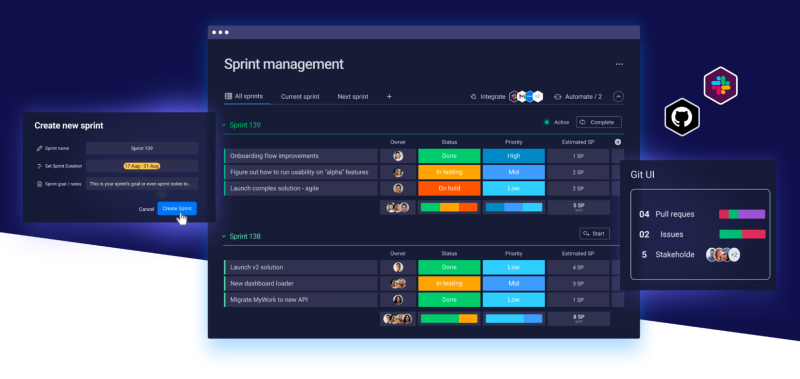
Monday integrates backlog management, roadmap planning, and bug tracking in one simple-to-use platform. It’s tailored for product management and offers Monday Dev, which is packed with features specific to development teams.
Rating: G2 - 4.7 stars
Demo: monday dev overview (enterprise) | monday.com tutorials.
Pricing: Plans start from $9.80 per seat per month.
Free trial: Yes.
Pros:
User-friendly and simple project tracking
Advanced reporting features and a variety of visualizations
Over 200 integrations and multiple tools for sprint management
Adaptable to a wide range of product management needs
Cons:
Mobile app functionality is limited compared to the desktop version
The platform’s extensive menu makes finding advanced features difficult
The interface can appear cluttered
Can be intimidating to new users
7. Asana
Asana is a great project tracking platform with a good selection of product management tools bundled in. The platform enhances collaboration and communication with automation and AI assistance to connect work to project goals, ensuring the product vision is in view during every step of development.
Rating: G2 - 4.3 stars
Demo: What is Asana?
Pricing: There is a free basic package for individuals and small teams. Paid plans start at $13.49 per user, per month.
Free trial: Yes.
Pros:
Great user experience
Good level of clarity and accountability
Over 300 integrations
Highly scalable and customizable
Cons:
Minimal product management tools mean Asana will need to be coupled with an additional platform for product management
Limited prioritization
Time tracking features are only available with the advanced plan
Tough to use for newcomers
8. Usersnap
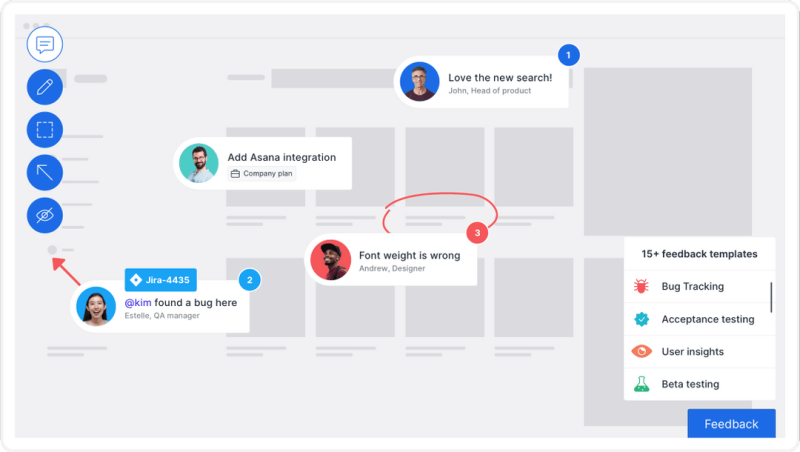
Usersnap is a powerful feedback tool that allows product owners to capture, organize, and respond to user feedback in one platform. Its functionality is centered around an unobtrusive and easy-to-install widget that can scale from a simple micro survey to screen captures. Product owners can also use this to target specific insights.
Usersnap also offers dedicated features specific to feedback from internal stakeholders.
Ratings: G2 - 4.5 stars
Demos: Usersnap - collect user feedback
Pricing: Plans start at $49 per month for 5 members.
Free trial: Yes.
Pros:
Seamless integration that encourages real-time user feedback directly on the website
Detailed bug reporting tool that allows customers to pinpoint specific issues
Saves time for support teams by directing them straight to the problem areas
Cons:
Focus on website integration might not be as useful for products without a web interface
May require technical knowledge to set up and integrate effectively with all website features
Reliance on user interaction with the widget could miss feedback from less engaged users
9. HotJar
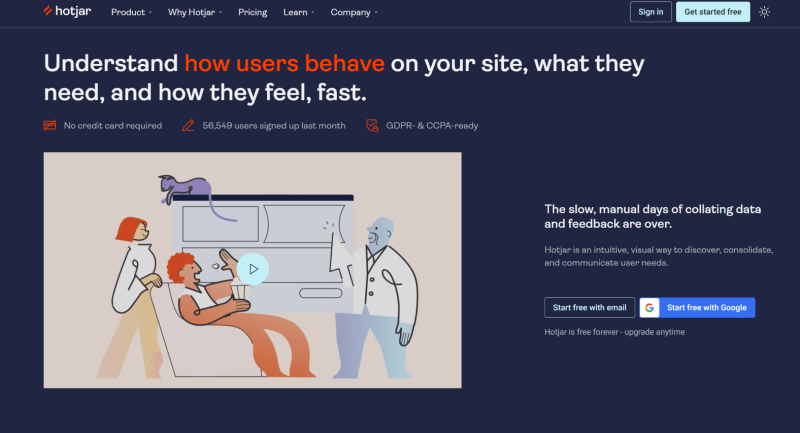
HotJar is an in-depth customer feedback platform that allows product owners to gain a deep understanding of user behaviors, needs, and feelings. Rather than just relying on analytics, HotJar offers heatmaps and recordings of how users interact with your website to see what is helping drive sales. This allows you to pinpoint UX issues and make changes that really affect your business.
Rating: G2 - 4.3 stars.
Demo: You can book a demo on their website.
Pricing: Free plan with basic features for up to 35 sessions daily, then $39 per month.
Free trial: Yes.
Pros:
A comprehensive set of tools for visualizing user behavior
Various feedback collection methods
Flexible pricing structure with free basic plans for their "Observe," "Ask," and "Engage" platforms
Cons:
Pricing structure can be confusing with so many options
May not be suited to smaller businesses
Steep learning curve
Choosing the right tool to work with your team
Product owners need tools to manage their backlog as they work with their team(s) to implement the product strategy. Tools that support them with prioritizing the backlog, assigning work, and keeping key stakeholders informed of progress.
With the many tools that are available on the market it can be difficult to find the right one that can support your product team. This is why your selection process will be a unique one that focuses on you and your teams’ specific needs.
We hope that we have given you a good starting point with this focused list.
Product Owner FAQs
Q1: What does a product owner do?
A1: The product owner is a key role within Scrum and is responsible for defining and prioritizing the work the development team will take on. The product owner will perform the following tasks:
Define user stories
Create and manage product backlog
Act as a bridge between product and development teams
Set priorities based on business value
Define product vision and goals
Engage with stakeholders
Approve or reject work
Q2: What skills do product owners need?
A2: Product owners need a blend of hard and soft skills to be effective in their role.
Hard skills for product owners include:
Software programming
Agile knowledge
UX research
Data analysis
Project management
Soft skills for product owners include:
Communication
Negotiation
People management
Problem-solving
Customer focus
Product owners should also be proactive about new techniques, trends, and workflows. Teams are expected to practice continuous learning and self-improvement, which needs to be led by someone higher up the chain.
Q3: What are some common challenges product owners face?
A3: Product owners need to overcome a range of challenges to ensure the product is developed to a high standard. The biggest challenge is prioritization. POs must decide which features and tasks provide the most value and should be tackled first, often balancing conflicting needs and limited resources. They must also manage the product backlog using careful refinement to ensure they are relevant, clear, and prioritized according to the current goals and feedback.
Communicating with stakeholders is also a demanding aspect of the PO role. POs need to ensure that all stakeholders, including customers, business leaders, and the development team are in constant alignment with the product vision and priorities, especially when they change at a fast pace. This requires clear, effective communication and often involves handling differing opinions.
POs often have to manage various tasks simultaneously, from strategic planning and stakeholder engagement to day-to-day oversight of the development process. Being able to multitask is a crucial skill to ensure this can be done effectively.
Q4: How do you become a product owner?
Becoming a product owner typically starts with a background in software development or programming. Often, this means holding a bachelor's degree in software engineering, product development, or related fields. Many aspiring product owners enhance their skills and knowledge by completing training or certification programs specific to product management.
Check out the airfocus blog to continue learning about product management including news, round-ups, and industry insights.
And to learn more about how airfocus can assist your product management team, book a demo with us today!

Quadri Oshibotu

Read also



Experience the new way of doing product management

Experience the new way of doing product management



